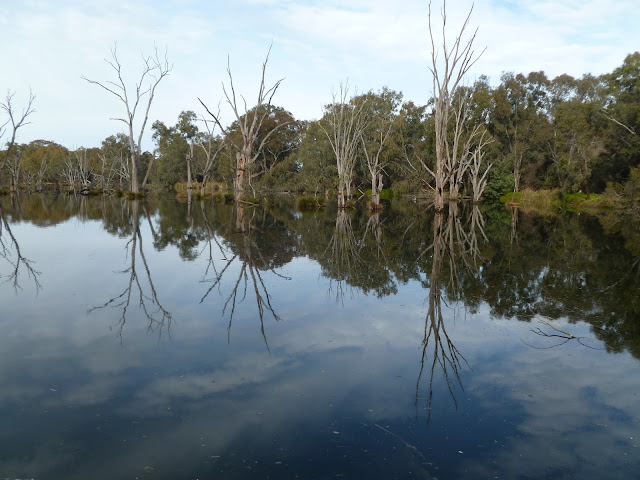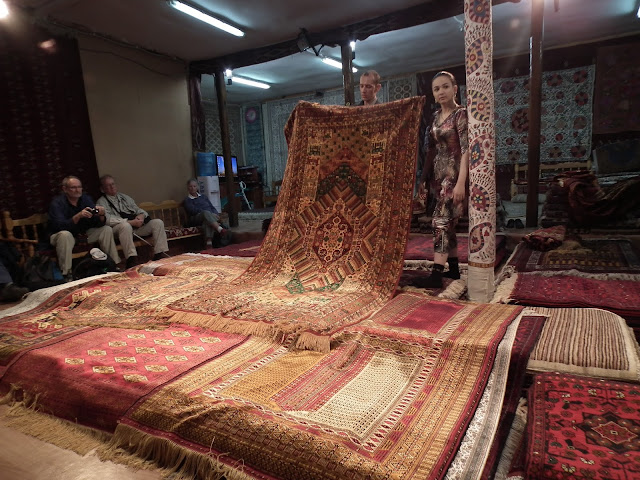If you've been following my blog you will already have seen the small carpet we brought home from Central Asia. Now I'd like to share some pics of some others we saw.
Let's start with Sabina, saleswoman extraordinaire in Bukhara, a lively, feisty young woman with fabulous English and a winning smile...... (how could you not buy a carpet from her?)
We were greeted with a bowl of green tea to sip while we listened to Sabina as she began her introduction to the world of carpets - and what a feast for the senses it was.......
The silk carpets were sublime - and of course expensive (all those hand knotted strands of silk) and were so soft and pliable they folded up small enough to slip into your day-pack - if you had the money to buy one - which I didn't........alas. These seemed to be the speciality of Uzbekistan, specifically Bukhara, where we were at the time.
She then went on to explain how and where the wool and camel hair carpets were made. (The wool carpets are generally made in Turkmenistan and the baby camel hair carpets (like ours) are generally made in Afghanistan). Interestingly these were generally much more to our taste which was just as well because it meant that it was more affordable - after a deep breath.
She also talked about the working conditions and went on to explain that their factories are internationally supervised to ensure no child labour is used and that the young women can nominate their own working hours as they are paid by the knot. This also helps protect their eyesight as it's very close work. (When the weavers are beginners they actually count the knots....more experienced and trusted employees have their work measured........)
No-one was working when we were there so Sabina gave us a quick demonstration using a silk carpet in progress.
She also explained about the diagrams or patterns used (set out like a cross stitch pattern)to create the traditional designs but went on the say that the girls can choose the colours themselves.....some apparently don't even need a pattern to follow.
Then to serious business......
Another high point was the Carpet Museum in Ashgabat, the Capital of Turkmenistan which was amazing - a world class facility being developed to preserve tradition and protect heritage. Unfortunately there weren't any postcards or printed matter on the collection so all I have is a few photos...... (Another place I could have spent hours and hours in.)
It has the largest handmade carpets in the world hanging on the walls in the entrance area. (The President and government keenly supports development and the standard of the modern architecture and museums and other facilities is testament to that - his photo around town on everything is testament to that....) They are huge - I didn't write down the stats but we are talking 30+ metres......
The guide we were supposed to have was with another group when we arrived so we were snaffled by an enthusiastic and knowledgeable Professor who jumped at the chance to practise her English and share her passion for carpets. Her parents, in particular her father, are apparently master weavers so she had a lot of information to share. (In fact she would have liked to have had us there for hours, as well. What a pity we had to rush off to our next attraction....)
We had a close look inside a yurt at the structure and carpets found inside - carpets on the walls, floor, carpet bags and cushions. Her talk was fascinating (and I'm pretty sure we weren't supposed to be in there, or take photos...)
(A little more detail.)
Our guide rushed some of us down to the basement where there were carpet weavers at work. These women were finishing off fringes......

Displays in the museum.......
Bags for carrying household goods by camel or horse when on the move.

.................... and a demonstration by our ebullient guide.......
Weavers at work elsewhere.........

This piece above was in a museum but they are found everywhere in front yards, courtyards, hotels and restaurants - carpets in action......
At our hotel in Samarkand - how did they know it was my birthday?
And when we got back from my birthday dinner..........they were waiting......

.....including the 5th floor of a complex with restaurants, nightclub etc overlooking the night lights of Ashghabat.

.......or as a stage for performance or a fashion parade....
There were examples in the Applied Arts museums in each of the four countries we visited and carpets in use everywhere. At one point one of our fellow travellers looked at me and said, "You're there, aren't you?" So true....... romantic visions of the nomadic life flashed in front of my face, only to crash and burn a few days later when we were faced with icy weather, ( see 'I Met a Traveller'.
Other museum pieces.....
In mosques and mausoleums......

Bazaars......

and guard posts.......
Sigh!!!
Sue xxxx
















































































